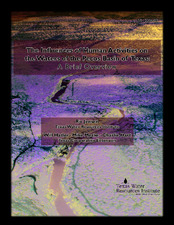| dc.description.abstract | The Pecos River in Texas is challenged by natural conditions and human influences, including a lack of water and elevated levels of salinity. The Pecos River has provided West Texas and Southeastern New Mexico an invaluable source of water for thousands of years allowing plants, animals, and humans to survive the harsh environment. The Trans-Pecos region generally marks the southwestern boundary of the Great Plains and the northeastern fringe of the Chihuahuan Desert. The Pecos River flows 926 miles through Texas and New Mexico draining a 38,000-square mile watershed (Huser, 2000; Graves, 2002; Horgan, 1984). The river flows approximately 418 miles through Texas and is the United States’ largest tributary to the Rio Grande.
According to the 2006 Far West Texas Regional Water Plan (LBG-Guyton, 2006), the Pecos River contributes roughly 11% of the flows in the Rio Grande entering Lake Amistad. Salinity from natural sources enters the river at many points, compromising water quality (Miyamoto et al., 2005; Miyamoto, 1996; Miyamoto, 1995). The Pecos River is estimated to contribute roughly 30% of the annual salt loadings to Lake Amistad (LBG-Guyton, 2006).
The Pecos River has been profoundly affected over time by the way humans use the river. Native Americans relied on the waters of the Pecos River as a source of fresh water even though some sections of the river were salty and foul-tasting. The river and occasional springs were the only sources of fresh water in the region. Spanish explorers and frontier cattlemen also used the Pecos River as a source of drinking water for humans, horses and cattle.
Although it is difficult to know the condition of the Pecos River of Texas as it existed before American settlement, some early accounts suggest that the river ranged from 65 to 100 feet wide and 7 to 10 feet deep with a fast current (Huser, 2000; Hall 2002). Now the river is rarely, if ever, that wide or deep under normal flow conditions. Dams and pumping water for irrigation have significantly altered the natural flow of the river.
In a turn-of-the-century report submitted to the Governor of Texas (Hollingsworth, 1892), conditions in the Pecos River were described in a way that reflects the natural resources dilemma still facing the region:
The want of rain in seasonable time is no doubt the principal reason that millions of acres of fertile soil are not utilized at all…Cattle, sheep, and horses…not only suffer, but in many localities frequently die for want of water and grass…We have to meet the questions, can anything be done to utilize the public lands of Trans-Pecos Texas and what can or must be done?...We have to consider that millions of acres of land with fertile soil are nearly valueless, if no provisions for irrigation are made.
By the late 1800s, American settlers began to develop the region for irrigation believing that the waters of the Pecos could support widespread agricultural production (Baggett, 1942; Bogener, 2003; Hayter, 1986). Throughout the Pecos Basin, many irrigation companies were created to attract settlers hoping to make a living by growing irrigated crops. Optimistic developers promoted irrigation projects with such grandiose names as Imperial and Royalty. Sadly, in many instances these attempts to create irrigated oases died quickly due to droughts and occasional floods.
The creation of Red Bluff Dam in the 1930s seemingly had the potential to harness the Pecos River and provide a steady water supply for the people of West Texas. The reservoir has succeeded in storing water for irrigation, but has been plagued by managerial and water quality challenges (Hall, 2002). The Pecos River Compact was enacted between Texas and New Mexico after Red Bluff was built to ensure that Texas would receive a fair proportion of Pecos River waters each year based on the amount of rainfall runoff that occurred in New Mexico. In 1987, the U.S. Supreme Court ruled that from 1950 to 1983 New Mexico’s water deliveries to Texas were 340,100 acre-feet (AF) less than the amount of water required under the compact. More recently, New Mexico water deliveries have increased to meet the demands of the Compact and more water is being released from Red Bluff Reservoir. New Mexico currently maintains a surplus of water stored in the reservoir.
The Pecos Basin of Texas is afflicted with major natural resources challenges. First, non-native saltcedar trees, introduced to the region to stabilize stream banks, now proliferate throughout the banks of the Pecos River. Saltcedars consume sizeable amounts of water, choke out native vegetation in riparian areas and increase salt loadings by drawing salts from below ground and depositing them on the surface in leaf litter (Belzer & Hart, 2006; Hart et al., 2005). Second, salts enter the river from natural deposits dissolved in rocks near Malaga Bend in southern New Mexico and between Grandfalls and Girvin, thus reducing the river’s quality (Boghici et al., 1999; LBGGuyton, 2003). Finally, the flows of the Pecos River are often not sufficient to support large-scale irrigation attempted in the past and present (Hall, 2002; Hill, 1965).
To find solutions to these challenges, the Pecos Basin Assessment Program was established in 2005 to develop innovative strategies to manage water resources in the region (Figure 1). The project, led by Texas Cooperative Extension in Fort Stockton, is developing a watershed protection plan for the Pecos Basin of Texas (Hart et al., 2005). Program activities involve identifying sources of salinity, modeling the flow of the river, and determining the extent to which clearing saltcedar might increase flows in the region. | en |


